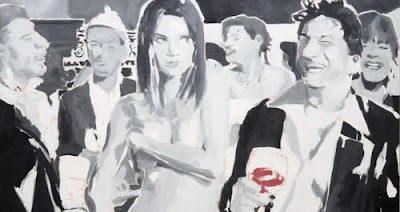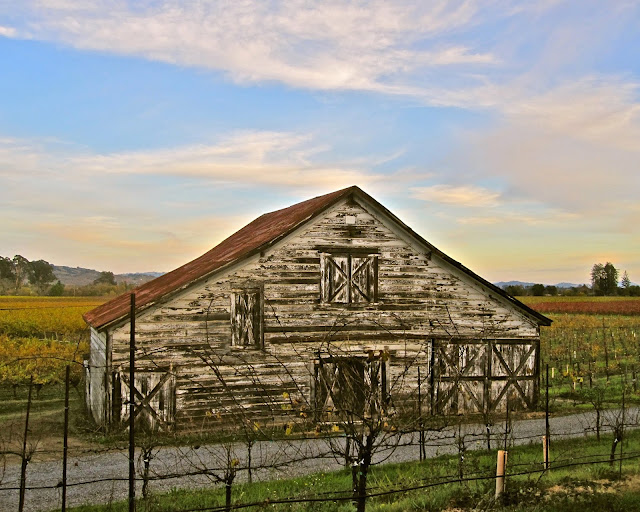Wine the grand illusion
 Does price affect the “quality” of wine? Yes, indeed it do.
Does price affect the “quality” of wine? Yes, indeed it do.At least according to results of a study conducted and released in early 2008 by Antonio Rangel, Associate Professor of Economics at the California Institute of Technology (re Wine Study Shows Price Influences Perception). Rangel asked twenty-one volunteers to blind-taste five different bottles of Cabernet Sauvignon and rate their preferences. The taste test was run fifteen times, and the wines presented in random order.
The only information given to the volunteers was price tags. However, two of the wines were presented twice; one with its true retail price, and the other with a fake price. They also presented one bottle that actually retailed for $90 as $10, and still another bottle that retailed for $5 as $45. To top it all off, according to the story, the dastardly researchers scanned the test subjects’ brains to monitor the “neural activity in the medial orbitofrontal cortex – an area of the brain believed to encode pleasure related to taste, odors and music.”
The results? Inflation of the price of a bottle consistently enhanced the subjects’ experience of it, as shown by the neural activity, and the volunteers consistently gave higher ratings to the more expensively priced wines. To quote Professor Rangel, “this study shows that the brain’s rewards center takes into account subjective beliefs about the quality of the experience… if you believe the experience is better, even though it’s the same wine, the rewards center of the brain encodes it as feeling better.”
Why am I not surprised? I’ve been talking about the grossly underestimated power of the mind when it comes to wine evaluation for years. At first, in the late 1970’s when I first got into the wine business and found myself being “mentored” by wine experts as old as I am right now (for the record, I’ve reached the big five-oh), I used to often wonder when we would taste, say, a ten to thirty year old bottle of Burgundy or Bordeaux, and my betters would go on and on about the glorious “bouquet,” the sensual “legs,” the “complex” flavors, and the “neverending” finishes. And all I would be tasting is an old, decrepit, tired wine. I admit often having doubts about my wine tasting prowess, despite Andre Simon’s old adage, “we may all have good taste, but not the same taste.”
By the early 1980’s I found myself with the privilege of attending two, three or four large scale wine exhibitions each year. You might know the scenario: huge auditoriums, hundreds of other wine professionals and connoisseurs milling about, choices of hundreds of different wines to taste. Naturally the biggest crowds were to be found around the tables presenting the most prestigious wines.
I remember one year – the 1988 Monterey Wine Festival, to be exact – in which the Heitz Martha’s Vineyard Cabernet Sauvignon was being poured, and I had to fight my way to the front for my little sip; and when I got there, the wine tasted awful! Dull, dreary, blah… yet there I was, surrounded by a crowd of people cooing with pleasure in contrast with my dismay. A half-hour or so later, worried that I may have had the bad luck of tasting from a corked bottle, I returned to the Heitz table, maneuvered my way up to the front again, and found my second tasting of the famed Martha’s to be no different than the first. In fact, it may have been worse.
And that’s when I decided right then and there, and for all-time:
- Most wine professionals are idiots – no better than herds of cattle – who couldn’t recognize a good, or lousy, bottle of wine if it hit them upside the head
- Well, to cut these idiots some slack – like most human beings, they’re simply swayed by the power of suggestion, particularly that of the established wine press (and who am I to question anyone’s humanity?)
Indeed, one of my favorite things to do in large consumer tastings over the years was to present two different, but similarly blended, wines of widely contrasting price points; for example: a $100 Quintessa compared to a $12 Casa Lapostolle Cuvée Alexandre. I would blind-taste the crowd, and ask for a show of hands on their preferences; and yes, I have found that for every fifty consumers expressing a preference for a $100 Quintessa, another fifty would prefer the $12 Lapostolle. Granted, you could say that they are “just consumers” who don't know what to look for. But like I said, what's worse is so-called “professionals” who know what to look for, and find it whether it's there or not. I’m happier when I see people who truly know what they like: never what someone tells them they should like. Ironically, it's "ordinary" consumers, not the pros, who are more likely to know what they like.
One of the most controversial wine pieces I’ve ever published was called Seven Ways to Improve Your Wine Life (March 2006). One of those seven topics was on the commonly accepted practice of improving the taste of wine by letting it “breathe.” As my original story went:
“Breathing.” We are often asked, especially in expensive restaurants: “Shall we open your bottle ahead of time to let it breathe?” Well, there are few things as preposterous as the notion that exposure of less than a square inch of wine at the neck of the bottle to the beneficial qualities of oxygen will result in increased quality of the wine therein. Not a chance.
Then there are the sommeliers who offer to “decant” your wine – pouring it from the bottle and into an open glass container – under the assumption that even more dramatic exposure to air will increase overall quality. If you ask me, another myth of the wine world. If anything, a wine – even a thick, heavy, youthful red wine – loses some of its freshness in the nose and flavor when allowed to “breathe” in a decanter. Yet there are many experts (including esteemed colleagues) who absolutely swear by the benefits of breathing, especially after hours in decanters. If you ask me again, I think it’s because the mind becomes more alerted to sharpening sensations over time (as well it should), not because a wine actually changes for the better.
To wit: in one recent Decanter magazine, a report done on a blind taste-test involving some of the UK’s most discriminating wine judges, who could not tell the difference or even establish a pattern of preference or quality level in wines that were decanted minutes before tasting, hours before tasting, or simply popped, poured, and tasted immediately. If anything, they preferred the latter, and I would concur: decanted wines are no likely to be better than undecanted wines.
Then again, if you have a beautiful decanter and you like using it to serve your guests, by all means use it. Quality of wine being such a state of mind, anything you do to make the perception of a wine experience a more positive one can only be good. As long as you understand the mythical nature of “breathing,” which makes the word itself illogical and thus to be avoided.
As it were, I received e-mails from more than a dozen wine cognoscente, most of them “professionals,” and most of them gently admonishing me for my apparent ignorance: everyone knows wines are improved by decanting and “breathing!” One reader even implied that I may have made up the Decanter story in question; either that, or there was something wrong with the wines or judges involved.
For the record: the Decanter issue cited in my story is from December 1997 (Vol. 23/No. 4), and the wines used for this tasting were a 1961 Mouton-Rothschild, a 1982 Clerc-Milon, a 1980 d’Armailhac, and a 1990 Mouton-Cadet. Of the six judges on that panel, the best known were Hugh Johnson, Serena Sutcliffe MW, Steven Spurrier and Patrick Leon. I’ve always been confident in my own palate, but even I have to admit that I might feel fear and trembling if ever given the opportunity to taste beside this bunch. Bottom line: if Hugh Johnson, Serena Sutcliffe, et al. can fess up to the finding that “opening and pouring wines straight away received by far the most acclaim regardless of the wine in question,” who am I to blow against the wind? Especially when I’ve long known the exact same thing.

My own conclusions, re decanting and oxygenating, after thirty years in the business of buying, selling and serving wine:
- It probably doesn’t hurt to decant a good red wine – be it old or young, a classic growth, an “amusingly naïve domestic” or otherwise – but the benefits are less significant than simply pouring into a good sized, properly shaped wine glass, swirling, and smelling the vapors emanating from the insides.
- Tannins in red wine do soften as they oxygenate in a decanter, but an even bigger factor is your sensory disposition – wines tend to soften and round out more because your palate becomes conditioned to the taste of tannin rather than because tannins undergo actual transformation on a molecular level.
- Aromas and flavors are affected by sensory disposition in the same way – nuances are more likely to sharpen and grow in attraction after a few minutes because the palate and mind become more attuned to them (especially when suggested by fellow tasters), not because a wine has physically “improved” on a molecular level as a result of oxygenation.
- Although great wines have been known to benefit from decanting (pro-breathers: I'm not arguing this point), wines over ten years old are just as likely to recede in quality if decanted more than a few minutes before consumption.
- For any wines over ten years old, the safest thing you can do is either pour the wine immediately from a just opened bottle into glasses, or pour into glasses immediately after decanting.
- Many changes commonly noted in decanted wines are actually due to fluctuating temperatures, which are huge (not minor) factors. Aromatic byproducts of esters and alcohol can vary drastically at different temperatures, as do the effect of tannin and alcohol on the taste buds. Red wines that are medium to high in tannin and body tend to taste tight and hard at temperatures below 60 degreees Fahrenheit, and harsh or rough above 72 degrees. If you prefer the natural, sweet berry perfume of red wines, I would say that the optimal serving temperature for most reds is somewhere between 62 and 68 degrees (well below normal "room" temperatures); closer to 60 for softer reds like Pinot Noir and Beaujolais style wines.
- Beauty is in the eye of the beholder the same way that perception of wine quality is highly individual. You know darn well that your taste in books, art, films, music, etc. are way different than other people’s – especially that of so-called experts or critics. The same thing with wine: only you can determine what you truly prefer.
That said, never underestimate the power of your own mind, and resist the suggestions of idiots!







Comments